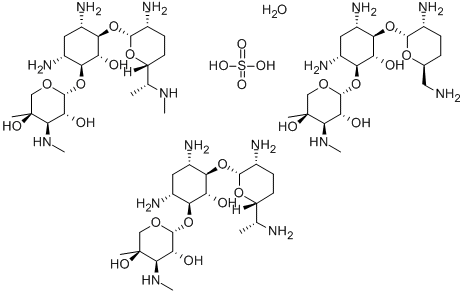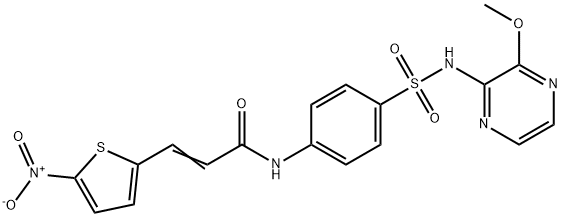Neomycinsulfate , 10mMinWater , 1405-10-3
Synonym(s):
Neomycin sulfate;Neomycin Sulfate - CAS 1405-10-3 - Calbiochem;Neomycin Sulfate, γ-Irradiated, Tissue Culture Grade - CAS 1405-10-3 - Calbiochem;Neomycin sulphate;Neomycin trisulfate salt
CAS NO.:1405-10-3
Empirical Formula: C23H48N6O17S
Molecular Weight: 712.72
MDL number: MFCD00037007
EINECS: 215-773-1
| Pack Size | Price | Stock | Quantity |
| 1ml | RMB399.20 | In Stock |
|
| others | Enquire |
PRODUCT Properties
| Melting point: | >187°C (dec.) |
| alpha | D20 +54° (c = 2 in H2O) |
| bulk density | 640kg/m3 |
| refractive index | 56 ° (C=10, H2O) |
| Flash point: | 56℃ |
| storage temp. | 2-8°C |
| solubility | H2O: 50 mg/mL As a stock solution. Stock solutions should be filter sterilized and stored at 2-8°C. Stable at 37°C for 5 days. |
| form | powder |
| color | white to slightly yellow |
| PH | 5.0-7.5 (50g/l, H2O, 20℃) |
| biological source | Streptomyces sp. |
| Water Solubility | Soluble in water |
| Merck | 14,6454 |
| Stability: | Stable. Incompatible with strong oxidizing agents. |
| InChIKey | OIXVKQDWLFHVGR-VTSVPHRWSA-N |
| LogP | -3.655 (est) |
| CAS DataBase Reference | 1405-10-3(CAS DataBase Reference) |
| EPA Substance Registry System | Neomycin sulfate (1405-10-3) |
Description and Uses
Neomycin sulfate is an aminoglycoside antibiotic and calcium channel protein inhibitor. Neomycin sulfate also binds to prokaryotic ribosomes inhibiting translation and is effective against gram-positive and gram-negative bacteria. Neomycin sulfate inhibits PLC (Phospholipase C) via binding to inositol phospholipids. It also inhibits phosphatidylcholine-PLD activity and induces Ca2+ mobilization and PLA2 activation in human platelets. Neomycin sulfate inhibits DNase I induced DNA degradation. It is used to prevent or treat skin infections caused by bacteria. It is not effective against fungal or viral infections.
Neomycin sulfate is an aminoglycoside antibiotic produced by S. fradiae that inhibits protein translation by binding to the small subunit of prokaryotic ribosomes. It blocks voltage-sensitive Ca2+ channels and is a potent inhibitor of skeletal muscle sarcoplasmic reticulum Ca2+ release. NEOMYCIN SULFATE has been shown to inhibit inositol phospholipid turnover, phospholipase C, and phosphatidylcholine-phospholipase D activity (IC50 = 65 μM). It is highly effective against Gram-positive and Gram-negative bacteria and is commonly used for the prevention of bacterial contamination of cell cultures.
Safety
| Symbol(GHS) |  GHS08 |
| Signal word | Danger |
| Hazard statements | H317-H334 |
| Precautionary statements | P261-P280-P342+P311 |
| Hazard Codes | Xn,Xi |
| Risk Statements | 42/43-22 |
| Safety Statements | 23-36/37-45-22-36-24/25 |
| WGK Germany | 3 |
| RTECS | QP4375000 |
| F | 8 |
| TSCA | Yes |
| HS Code | 29419000 |
| Toxicity | LD50 oral in mouse: > 8gm |



